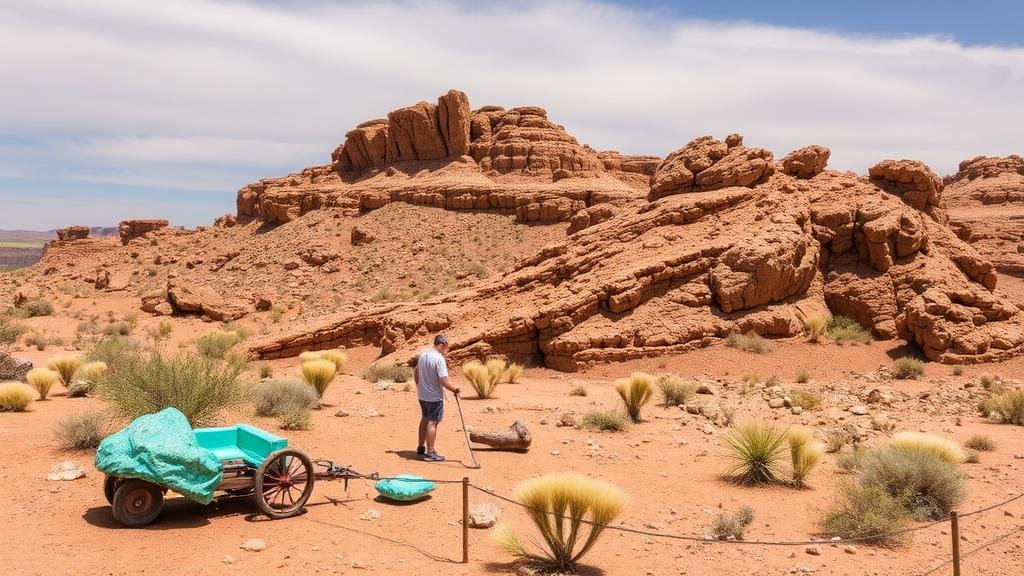Turquoise Treasures of the Desert: Rediscovering Ancient Mining Areas
Turquoise Treasures of the Desert: Rediscovering Ancient Mining Areas for Rockhounds and Mineral Collectors
Turquoise has captivated humanity for millennia, esteemed not only for its striking blue hues but also for its cultural significance and rarity. For rockhounds and mineral collectors, rediscovering ancient mining areas where turquoise was once abundant offers not just an opportunity to find beautiful specimens but also a deep dive into geological history and human heritage. This article explores the ancient mining locations of turquoise, the geological characteristics that make these areas special, and practical tips for collectors.
The Historical Context of Turquoise Mining
Turquoise mining dates back thousands of years, with some of the oldest known sources located in the Southwest United States and the Middle East. ancient Egyptians prized turquoise, sourcing it from the Sinai Peninsula, where it remains an integral part of the regions mineralogy. In the Americas, tribes such as the Navajo and Zuni have utilized turquoise in their jewelry and cultural artifacts for generations. These historical contexts enrich the experience of collectors who seek not just the stone itself but also its story.
Geological Characteristics of Turquoise
Turquoise is a hydrated copper and aluminum phosphate with the chemical formula CuAl6(PO4)4(OH)8·4H2O. Its unique blue to green coloration arises from copper and iron impurities. For rockhounds, understanding the geological conditions that favor turquoise formation can enhance their collecting efforts. Turquoise is typically found in arid regions, particularly in sandstone and limestone environments where weathering processes can concentrate copper-bearing minerals.
Notable Ancient Mining Sites
Several important ancient turquoise mining areas remain significant for collectors today:
- Turquoise Mountain (Serabit el-Khadim), Egypt: This site has been mined since circa 3000 BCE, producing exquisite turquoise artifacts now housed in museums worldwide.
- Chalchihuitl, Mexico: A historical source of turquoise that dates back to the Mesoamerican period, often used in religious artifacts.
- Royal Arch Mine, Arizona, USA: Once a bustling mining operation, this site is renowned for producing high-quality turquoise, popular among modern collectors.
- Lone Mountain, Nevada, USA: An area famous for its unique water and sky-blue turquoise, it remains a point of interest for rockhounds.
Practical Tips for Collectors
For those interested in exploring these ancient turquoise mines, several important considerations can enhance the experience:
- Research Visiting Regulations: Many mining sites, especially those situated on private land, may have restrictions. Prior research can help you obtain necessary permits or find accessible locations.
- Field Equipment: Having the right tools is essential. Equip yourself with hammers, chisels, and safety gear. A sturdy field guide can help identify turquoise and similar minerals.
- Join Local Rockhounding Clubs: Engaging with experienced collectors can provide valuable insights and experiences about where to find turquoise effectively.
- Identify Authenticity: Different types of turquoise exist, from natural to stabilized and created stones. Understanding these categories promotes informed purchasing and collecting.
The Future of Turquoise Mining
As demand for turquoise continues to grow, particularly in jewelry and artwork, concerns regarding sustainability and ethical sourcing have arisen. Its crucial for modern collectors to be informed about the origins of their specimens. Responsible mining practices and transparency in the supply chain are essential to preserve these precious resources, ensuring that future generations can appreciate them as we do today.
Conclusion and Actionable Takeaways
Rediscovering ancient turquoise mining areas can lead to fruitful collecting adventures while also enriching your understanding of geology and history. By arming yourself with knowledge about the sites, geological characteristics, and sustainable practices, you can enhance both your collection and your appreciation for this stunning mineral. Here are some actionable takeaways:
- Research historical mining sites noted for turquoise.
- Equip yourself with the right tools and knowledge before heading out.
- Network with local rockhounding groups to share experiences and tips.
- Commit to ethical collecting practices to ensure the longevity of turquoise as a natural resource.
Embrace the adventure of exploration and deepen your connection to the earths treasures through the fascinating world of turquoise mining.


